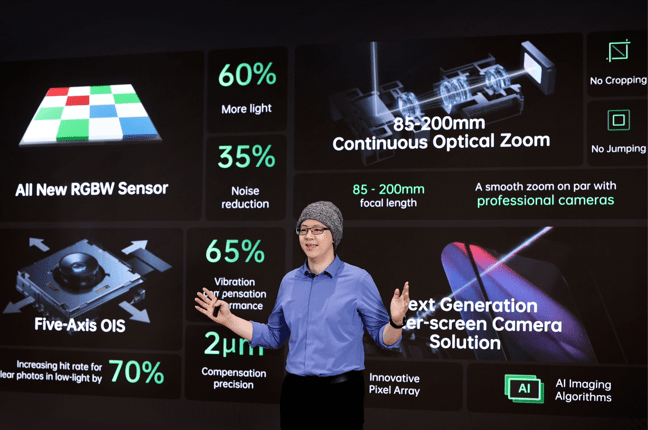During the Future Imaging Technology event, Oppo showed the new technologies in the field of smartphone photography. Let’s find out together
OPPO, one of the world’s leading companies in the smart device sector, unveiled at theevent dedicated to photography “OPPO Future Imaging Technology 2021“, several innovations In the imaging industry its smartphone, strongly focused on sensor updates, moduli e algorithms. The company has concentrated on development e optimization of the most important technologies from imaging currently existing to allow all users to “capture the colors of the world in their beauty with ease”.
Among these innovations are: the RGBW sensor from new generation of OPPO, lo continuous optical zoom 85-200mm, technology OPPO Five-axis OIS and the camera under the screen OPPO’s next generation, with a series of AI algorithms owners. Thanks to these technologies, OPPO elevates further the standard In the imaging industry its smartphone, improving diverse functionality, as the sensitivity to light, the power of the zoom, the stabilization e much more.

Oppo Future Imaging Technology: The next generation RGBW sensor for greater light sensitivity, with unprecedented performance
The RGBW sensor new generation of OPPO gets better significantly the sensitivity to light introducing additional white sub-pixels (W), the revolutionary DTI technology e the algorithm from pixel 4-in-1 developed by OPPO. As a result, this new sensor allows for capture 60% more light compared to previous sensors and get a 35% noise reduction, to offer Images more clear e bright, even in low light conditions.

OPPO’s next-generation RGBW sensor.
The new generation RGBW sensor is made with a production technology ed advanced processing, increasing so the level from power calculation required for run complex algorithms e maximizing the amount from data extracted through white pixels sensor. L’algorithm owner of the pixel 4-in-1 helps improve significantly the performance concerning the color, preventing problems like the imprecision of colors e i moiré patterns. Furthermore, the technology industry leader of isolation of the pixel DTI e DeepSi processing prevent effectively the sub-pixel crosstalk, improving the overall quality image.
In addition to improving the acquisition of photos in low light conditions, the sensor RGBW new generation is capable of make portraits more expressive, both in Photo that in video, in terms of structure e contrast. This new sensor will be marketed in OPPO devices starting from fourth quarter 2021.
New modules: OPPO 85-200mm continuous optical zoom, for super smooth zoom, and OPPO Five-axis OIS, for even sharper shots
This new continuous optical zoom 85-200mm redraws the form completely structural at the level of hardware:
- Adopt the technology from the G + P lenses (glass and plastic), introducing two lenses aspherical glass ultra-thin and high precision for to increase significantly the optical effects, as the minimization of the distant light.
- The innovative application of a tunnel magnetoresistance sensor (TMR sensor) allows the lenses inside of the camera module move with major stability e precision.
- The driving motor recently updated increases the dynamic inclination with which the system from lenses could be moved, easily supporting it optical zoom I continue to higher magnifications.

OPPO 85-200mm Continuous optical zoom.
These innovations support at best it optical zoom I continue to focal lengths equivalents, between 85mm e 200mm, capturing sharp images at each zoom level, come on portraits more close together to the distant landscapes. In addition, users can enjoy one transition super fluids throughout the zoom range, with a quality dell’comparable image to that of one professional camera. Finally, this one new technology avoids i classic problems more conventional multi-camera zoom systems, such as imprecision from balancing of the White o la distortion of the color.
Among the news also OIS a five aces, which allows the processor system of receive i data from movement from the gyroscope, analyzing and breaking them down through the different algorithms. This data comes later passed to the two moving components: the target and the image sensor, guided respectively from engines a ball e alloys a memory from shape.
When the movement it is relatively little, the pictures are stabilized mainly through l’OIS lens-shift – which covers it shift horizontal (X) and vertical (AND). When the breadth of the movement it is relatively great, however, it will also be used l’OIS sensor-shift – including displacement horizontal (X), the displacement vertical (Y) e la rotation — together at the compensation of the algorithm, to obtain the five-axis stabilization of space.
This allows for a angle from maximum stabilization from ±3°, three times more than traditional OIS technology found on mobile devices, while the sensor can also move with a accuracy of 2μm. Also, for the night shots or movement, the algorithmic technology OPPO owner can help a improve significantly the stability, the clarity and the performance of the colors, increasing the performance of vibration compensation until the 65%. OPPO Five-axis OIS Sara released commercially in products OPPO from Q1 2022.

OPPO five-axis OIS technology.
New OPPO algorithms that support next generation under-screen camera, to offer the perfect balance between display and camera quality
In the end, OPPO presented its camera solution under the display next generation, present in future smartphones of the company. The innovative pixel geometry ensures a visualization from high quality a 400PPI nell’area of the camera below the screen. Using a transparent wiring and a new design, the result is one display quality much more refined, with a visual experience even more fluid. With each pixel circuit that pilots alone 1 pixel (“1 to 1”) in the screen and the need technology from compensation algorithmic of OPPO, the chromaticity and the brightness of the entire screen are check with greater accuracy, with a deviation of only the 2% about and one time of the improved screen until the 50%.
Furthermore, theAmerican Research Institute from OPPO has developed a serie from AI algorithms from imaging – including the reduction of the diffraction, anticondensation, l’HDR and theAWB — per optimize the best quality from the captured images through the camera below the screen. In particular, the model of reduction of the AI diffraction of OPPO was studied using tens of thousands from Images per to check i problems caused by the light, allowing users to capture clearer photos and fromappearance still more natural.
Per satisfy always new needs when it comes to imaging users around the world, OPPO stands investing much in the Research and in development of these areas. Currently, OPPO has 6 research institutes, 5 R&D centers e dozens of laboratories from imaging around the world, including the new laboratory imaging of Hyderabad, in India, and the imaging laboratory of Yokohama, in Japan, responsible for creation of a series of technologies developed on their own from OPPO e present in next Reno Series. Constantly looking to the future, OPPO will continue a to focus on the implementation of imaging technologies self-developed e will strengthen even more his cooperation con i industrial partners to provide users with aexperience di imaging always better.
What do you think of the technology developed by Oppo? Let us know yours in the comments section, then I invite you to follow our mobile section so as not to miss any news or reviews.














Leave a Reply
View Comments